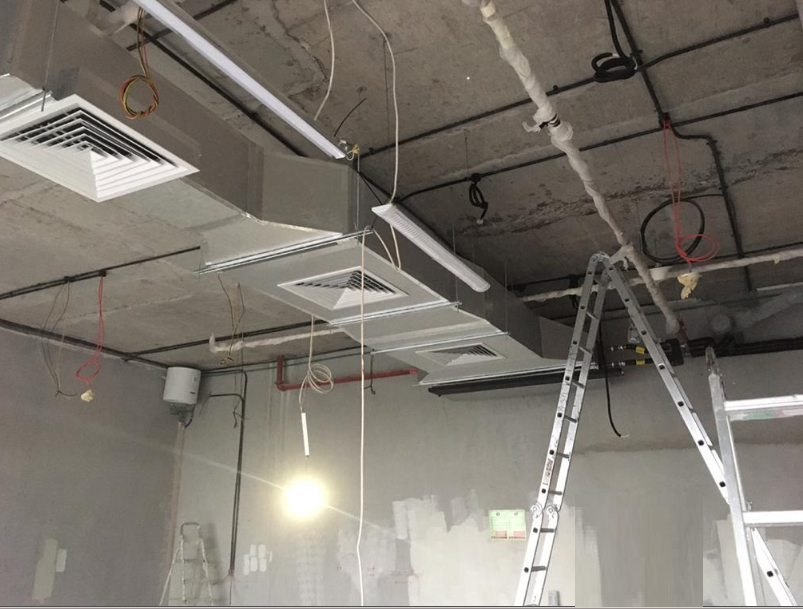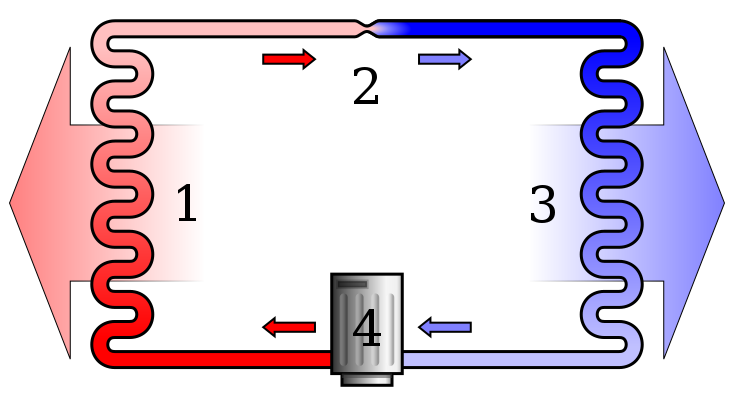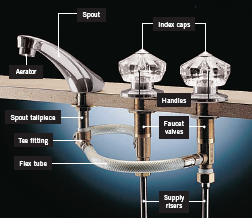Air conditioner, often abbreviated as A/C or AC, is the process of removing heat and controlling the humidity of air in an enclosed space to achieve a more comfortable interior environment by use of powered "air conditioners" or a variety of other methods, including passive cooling and ventilative cooling. Air conditioner is a member of a family of systems and techniques that provide heating, ventilation, and air conditioner (HVAC).
 |
| Air Conditioner |
Air Conditioner
Whats the mean Air Conditioner ?
Air conditioner, often abbreviated as A/C or AC, is the process of removing heat and controlling the humidity of air in an enclosed space to achieve a more comfortable interior environment by use of powered "air conditioners" or a variety of other methods, including passive cooling and ventilative cooling. Air conditioner is a member of a family of systems and techniques that provide heating, ventilation, and air conditioner (HVAC).
Air conditioners, which typically use vapor-compression refrigeration, range in size from small units used within vehicles or single rooms to massive units that can cool large buildings. Air source heat pumps, which can be used for heating as well as cooling, are becoming increasingly common in cooler climates.
Operating principles
 |
| A simple stylized diagram of the refrigeration cycle |
Legend
- Condenser coil (hot side heat exchanger, gas cools and liquifies)
- Metering Device (liquid expands and cools)
- Evaporator coil (cold side heat exchanger, liquid vaporizes and heats up)
- Compressor (gas is compressed and heats up)
Red = Gas at high pressure and very high temperature
Pink = Liquid at high pressure and high temperature
Blue = Liquid at low pressure and very low temperature
Light Blue = Gas at low pressure and low temperature
Operating principles
Cooling in traditional AC systems is accomplished using the vapor-compression cycle, which uses the forced circulation and phase change of a refrigerant between gas and liquid to transfer heat. The vapor-compression cycle can occur within a unitary, or packaged piece of equipment; or within a chiller that is connected to terminal cooling equipment (such as a fan coil unit in an air handler) on its evaporator side and heat rejection equipment such as a cooling tower on its condenser side. An air source heat pump shares many components with an air conditioning system, but includes a reversing valve which allows the unit to be used to heat as well as cool a space.
Air conditioning equipment will reduce the absolute humidity of the air processed by the system if the surface of the evaporator coil is significantly cooler than the dew point of the surrounding air. An air conditioner designed for an occupied space will typically achieve a 30% to 60% relative humidity in the occupied space.
Most modern air-conditioning systems feature a dehumidification cycle during which the compressor runs while the fan is slowed to reduce the evaporator temperature and therefore condense more water. A dehumidifier uses the same refrigeration cycle but incorporates both the evaporator and the condenser into the same air path; the air first passes over the evaporator coil where it is cooled and dehumidified before passes over the condenser coil where it is warmed again before being released back into the room again.[citation needed]
Free cooling can sometimes be selected when the external air happens to be cooler than the internal air and therefore the compressor needs not be used, resulting in high cooling efficiencies for these times. This may also be combined with seasonal thermal energy storage.
Types of air conditioner
- Mini-split and multi-split systems
Ductless systems (often mini-split, though there are now ducted mini split) typically supply conditioned and heated air to a single or a few rooms of a building, without ducts and in a decentralized manner. Multi-zone or multi-Split Systems are a common application of ductless systems and allow up to eight rooms (zones or locations) to be conditioned independently from each other, each with its own indoor unit and simultaneously from a single outdoor unit. The main problem with multi-split systems is the length of the refrigerant lines for connecting the external unit to the internal ones.[citation needed] Though the same challenge exists for central ACs.
- Ducted central systems
 |
| Ducted central systems |
Split-system central air conditioners consist of two heat exchangers, an outside unit (the condenser) from which heat is rejected to the environment and an internal heat exchanger (the fan coil unit, air handling unit, or evaporator) with the piped refrigerant being circulated between the two. The FCU is then connected to the spaces to be cooled by ventilation Ducts.
- Central plant cooling
Large central cooling plants may use intermediate coolant such as chilled water pumped into air handlers or fan coil units near or in the spaces to be cooled which then duct or deliver cold air into the spaces to be conditioned, rather than ducting cold air directly to these spaces from the plant, which is not done due to the low density and heat capacity of air which would require impractically large ducts. The chilled water is cooled by chillers in the plant, which use a refrigeration cycle to cool water, often transferring its heat to the atmosphere even in liquid-cooled chillers through the use of cooling towers. Chillers may be air or liquid-cooled.[citation needed]- Portable units
A portable system has an indoor unit on wheels connected to an outdoor unit via flexible pipes, similar to a permanently fixed installed unit (such as a ductless split air conditioner).
Hose systems, which can be monoblock or air-to-air, are vented to the outside via air ducts. The monoblock type collects the water in a bucket or tray and stops when full. The air-to-air type re-evaporates the water and discharges it through the ducted hose and can run continuously. Such portable units draw indoor air and expel it outdoors through a single duct.
Many portable air conditioners come with heat as well as dehumidification function.

Portable units
- Window unit and packaged terminal
The packaged terminal air conditioner (PTAC), through-the-wall, and window air conditioners are similar. PTAC systems may be adapted to provide heating in cold weather, either directly by using an electric strip, gas, or other heaters, or by reversing the refrigerant flow to heat the interior and draw heat from the exterior air, converting the air conditioner into a heat pump. They may be installed in a wall opening with the help of a special sleeve on the wall and a custom grill that is flush with the wall and window air conditioners can also be installed in a window, but without a custom grill.
Packaged air conditioner
Large central cooling plants may use intermediate coolant such as chilled water pumped into air handlers or fan coil units near or in the spaces to be cooled which then duct or deliver cold air into the spaces to be conditioned, rather than ducting cold air directly to these spaces from the plant, which is not done due to the low density and heat capacity of air which would require impractically large ducts. The chilled water is cooled by chillers in the plant, which use a refrigeration cycle to cool water, often transferring its heat to the atmosphere even in liquid-cooled chillers through the use of cooling towers. Chillers may be air or liquid-cooled.[citation needed]
- Portable units
A portable system has an indoor unit on wheels connected to an outdoor unit via flexible pipes, similar to a permanently fixed installed unit (such as a ductless split air conditioner).
Hose systems, which can be monoblock or air-to-air, are vented to the outside via air ducts. The monoblock type collects the water in a bucket or tray and stops when full. The air-to-air type re-evaporates the water and discharges it through the ducted hose and can run continuously. Such portable units draw indoor air and expel it outdoors through a single duct.
Many portable air conditioners come with heat as well as dehumidification function.

Portable units
- Window unit and packaged terminal
The packaged terminal air conditioner (PTAC), through-the-wall, and window air conditioners are similar. PTAC systems may be adapted to provide heating in cold weather, either directly by using an electric strip, gas, or other heaters, or by reversing the refrigerant flow to heat the interior and draw heat from the exterior air, converting the air conditioner into a heat pump. They may be installed in a wall opening with the help of a special sleeve on the wall and a custom grill that is flush with the wall and window air conditioners can also be installed in a window, but without a custom grill.
Packaged air conditioner
A portable system has an indoor unit on wheels connected to an outdoor unit via flexible pipes, similar to a permanently fixed installed unit (such as a ductless split air conditioner).
Hose systems, which can be monoblock or air-to-air, are vented to the outside via air ducts. The monoblock type collects the water in a bucket or tray and stops when full. The air-to-air type re-evaporates the water and discharges it through the ducted hose and can run continuously. Such portable units draw indoor air and expel it outdoors through a single duct.
Many portable air conditioners come with heat as well as dehumidification function.
 |
| Portable units |
- Window unit and packaged terminal
The packaged terminal air conditioner (PTAC), through-the-wall, and window air conditioners are similar. PTAC systems may be adapted to provide heating in cold weather, either directly by using an electric strip, gas, or other heaters, or by reversing the refrigerant flow to heat the interior and draw heat from the exterior air, converting the air conditioner into a heat pump. They may be installed in a wall opening with the help of a special sleeve on the wall and a custom grill that is flush with the wall and window air conditioners can also be installed in a window, but without a custom grill.
The packaged terminal air conditioner (PTAC), through-the-wall, and window air conditioners are similar. PTAC systems may be adapted to provide heating in cold weather, either directly by using an electric strip, gas, or other heaters, or by reversing the refrigerant flow to heat the interior and draw heat from the exterior air, converting the air conditioner into a heat pump. They may be installed in a wall opening with the help of a special sleeve on the wall and a custom grill that is flush with the wall and window air conditioners can also be installed in a window, but without a custom grill.
Packaged air conditioner
Packaged air conditioners (also known as self-contained units) are central systems that integrate into a single housing all the components of a split central system, and deliver air, possibly through ducts, to the spaces to be cooled. Depending on their construction they may be outdoors or indoors, on roofs (rooftop units), draw the air to be conditioned from inside or outside a building and be water, refrigerant or air-cooled. Often, outdoor units are air-cooled while indoor units are liquid-cooled using a cooling tower.
DOWNLOAD also HVAC Design Calculations Formulas Handbook .DOWNLOAD also Chilled Water System Pipes Sizing Execl Sheet ( XLS).
Packaged air conditioners (also known as self-contained units) are central systems that integrate into a single housing all the components of a split central system, and deliver air, possibly through ducts, to the spaces to be cooled. Depending on their construction they may be outdoors or indoors, on roofs (rooftop units), draw the air to be conditioned from inside or outside a building and be water, refrigerant or air-cooled. Often, outdoor units are air-cooled while indoor units are liquid-cooled using a cooling tower.
DOWNLOAD also HVAC Design Calculations Formulas Handbook .
DOWNLOAD also Chilled Water System Pipes Sizing Execl Sheet ( XLS).





0 Comments